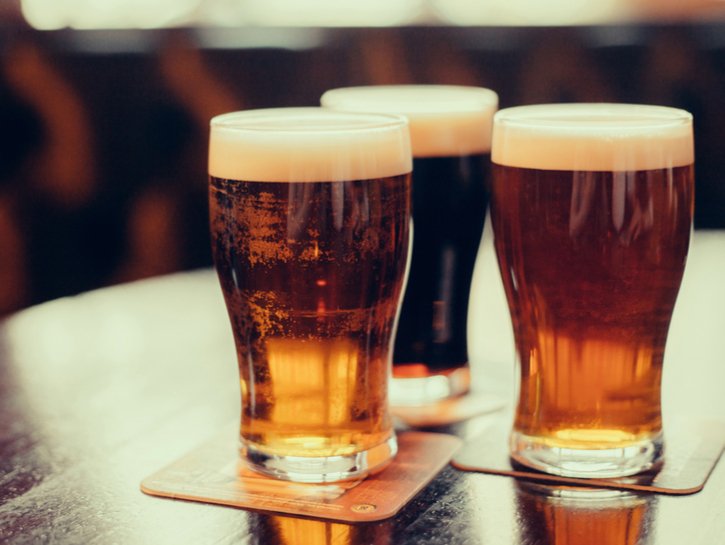All beers fall into one of two categories: ales or lagers. The difference between the two depends solely on the beer’s fermentation process, which is when the yeast converts the glucose into ethyl alcohol and carbon dioxide. Lagers are made with yeast that ferments at the bottom of the beer mixture, and ales are made with yeast that ferments up toward the surface.
Though there are many different types and variations of beer ranging in alcohol content (known as alcohol by volume, or ABV), color (using the Standard Reference Method, or SRM, a color scale ranging roughly 1 to 40, a high number means a darker beer) and flavor (ranked on the International Bittering Units scale, or IBU, ranging from 1 to 100, a high number means more hops), all of them are categorized as either an ale or lager.
Ales
Wheat Beer
As their name suggests, wheat beers are made with wheat as their malt. They’re one of the lightest beers both in color and in alcohol content. Depending on the beer, these drinks can taste bread-like or fruity and go well when served with lighter foods including soft cheeses and white meat.
ABV: 3.5-5.6%
IBU: 10-35
SRM: 2-10

Viacheslav Rubel/Shutterstock
American Pale Ale
American Pale Ales are beers included under the umbrella term “pale ale,” and are often referred to as APAs. They have a relatively equal malt-to-hop ratio and a copper color, but still have a light flavor.
ABV: 4.4-5.4%
IBU: 30-50
SRM: 6-14

Det-anan/Shutterstock
India Pale Ale
Unlike American Pale Ales, India Pale Ales (or IPAs) are much, much hoppier. The large amount of hops makes the beer almost aggressively bitter. So if you’re a lover of strong, unflinching flavors, IPAs are for you. This beer is also more alcoholic than American Pale Ales, with an ABV of up to 7.5 percent.
ABV: 6.3-7.5%
IBU: 50-70
SRM: 6-12

Joshua Resnick/Shutterstock
Saison
Saisons are pale ales from Belgium that are highly carbonated with a fruity and almost spicy taste. They range from a cloudy golden to reddish amber color with an earthy, medium-hop flavor.
ABV: 4.4-6.8%
IBU: 20-38
SRM: 5-7

English Bitter
Unlike more mild pale ales, the English Bitter has more hops and malts than lighter-bodied beers such as pilsners, but the alcohol content is still relatively low, not exceeding 5 ABV. English Bitters vary in color from gold to dark amber and, despite what the drink’s name might suggest, have a very mild taste.
ABV: 3-4.2%
IBU: 20-35
SRM: 5-12

Claudio Divizia/Shutterstock
Brown Ale
This dark amber beer is one of the world’s oldest varieties of beer, dating back to 17th century London. Brown ale burst into the American commercial scene in 1986 when craft beer pioneers Pete Slosberg and Mark Bronder released Pete’s Wicked Ale, and the variety has been popular ever since for its malty flavor and bitter kick of hops. The beer also has a warm caramel or chocolate undertone.
ABV: 4-5.5%
IBU: 15-25
SRM: 12-17

Brent Hofacker/Shutterstock
Porter
Porters are traditionally heavy beers, but are vaguely fruity and less bitter than the much heavier, blacker stouts. They are made with hops, dark malted barley and top-fermenting ale yeasts. Porters are also one of the oldest beers, originating in London during the 1900s.
ABV: 4.5-6%
IBU: 20-30
SRM: 20-35

Krill Z/Shutterstock
Stout
Traditionally, stouts are the heaviest, most alcoholic beers. They were first brewed in London as well when brewers began experimenting with porter recipes. These beers are denser, creamier and more bitter than porters, and often have a coffee-like flavor. However, the difference between stouts and porters isn’t exactly universal.
ABV: 5.7-8.9%
IBU: 35-60
SRM: 40-45

MaxyM/Shutterstock
Lagers
Pilsner
Pilsners are pale lagers with low alcohol content, but are more hoppy and bitter than sweet wheat beers. It’s one of the youngest beers in existence and was first brewed in 1842 in what is now modern-day Czech Republic.
ABV: 3.2-4%
IBU: 5-15
SRM: 2-6

Krill Z/Shutterstock
Amber Lager
Amber lagers are heavier than pilsners and other pale lagers and have a mild nutty and sweet flavor, often with undertones of caramel. They can contain very few hops for no bitterness or be very hoppy depending on the brewer’s recipe.
ABV: 4.8-5.4%
IBU: 18-30
SRM: 6-14

Krill Z/Shutterstock
Dark Lager
Before pale lagers were introduced in the late 19th century, dark lagers dominated. These beers are typically an amber or red-brown color because they are made from dark malts. Despite their dark color, these beers have a chocolate and bread-like aroma, and although they’re heavier than pale lagers, they’re not as overwhelmingly dense as porters or stouts.
ABV: 4.8-5.3%
IBU: 16-25
SRM: 15-17

Krill Z/Shutterstock
Bock
German Bock beers are dark, strong, light on hops and heavy with malts, so they are surprisingly sweet. This lager is traditionally consumed at spring festivals in Germany after being brewed in the autumn.
ABV: 6.3-7.5%
IBU: 20-30
SRM: 20-30

GCapture/Shutterstock
